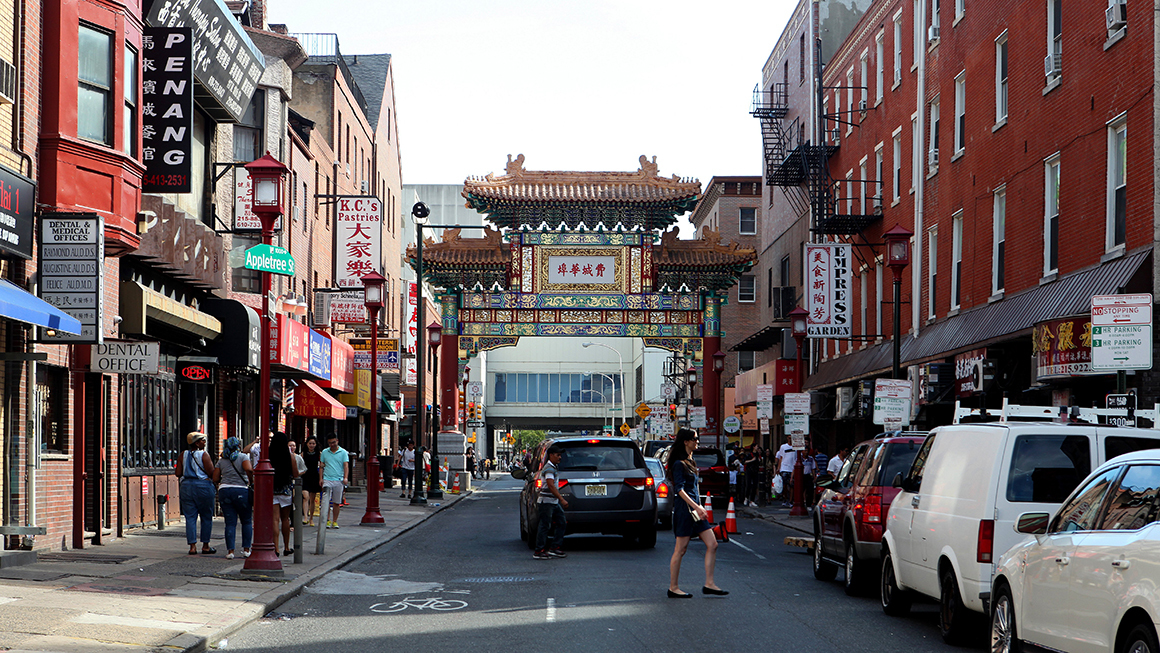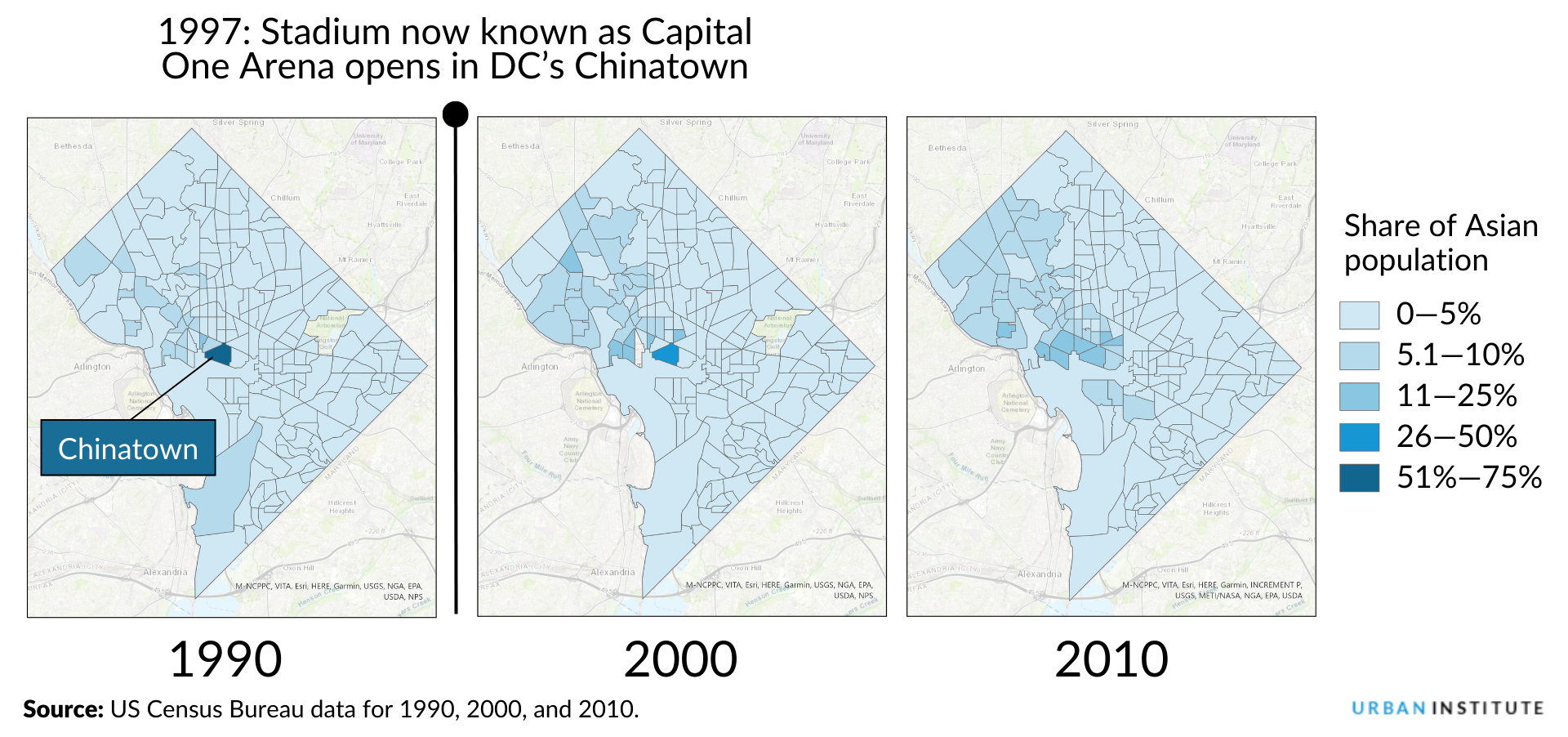
请读中文版文章 (view the Chinese version of this post).
In 2022, developers proposed building an arena for the 76ers basketball team next to Philadelphia’s Chinatown. Three years later, they announced they would not be moving after all and would instead stay in South Philadelphia.
The January 2025 announcement came after Philadelphia Mayor Cherelle Parker and 12 out of 17 council members approved the plan in December 2024. That decision was met with pushback from many community groups, such as the Save Chinatown Coalition, Asian Americans United, Black Philly for Chinatown, and Juntos.
For years, community groups claimed that the developers, a group called 76 Dev Corp, had not fully considered how the arena could displace residents, hurt small businesses, and lead to losses of cultural identity in Chinatown. In its 150-year history, the neighborhood has been affected by the development of an expressway and convention center and fought off proposals for a prison and a casino.
According to the developers, the new arena would have revived the fading shopping area next to Chinatown: Market Street East. They claimed the arena would bring thousands of new jobs and generate $1.5 billion in tax revenue over 30 years.
However, in a review of independent data, we find that the developers largely overstated the economic benefits of the new arena. Independent evaluations reveal the plan would have likely led to job losses at local businesses, a loss in tax revenue, fewer economic benefits for Philly’s Black communities than promised, and the displacement of Chinatown residents.
Although the arena developers have abandoned their plans for Market Street East, the city still aims to redevelop the area. Here, we use independent data to explain why four claims the developers made in their proposals are unrealistic. We also highlight how the city can work to make sure redevelopment proposals will benefit all Philadelphians.
1. Independent evaluations estimated the arena would only create 710 jobs and could have caused local businesses to lose 7,890 jobs.
76 Dev Corps claimed the arena would create more than 9,000 full-time construction jobs and 1,000 permanent jobs in an unspecified time frame.
But an economic impact analysis (PDF) requested by the City of Philadelphia predicted it would only create 710 full-time jobs over 30 years. That’s 8,390 fewer jobs than 76 Dev Corp promised.
A separate independent study pointed out that the developers did not fully consider how the arena and its construction could affect local businesses. This study estimated that 7,890 local jobs (PDF) could be lost because of the arena.
When a large project is built, it typically raises nearby rents and taxes (PDF). This can affect both residents and local businesses. If they can’t afford these higher prices, they’re forced to move out of the neighborhood or close down their business. This process, called displacement, can lead to a loss of cultural identity for those who remain in the neighborhood.
2. One independent study suggested the proposed arena would cost the city up to $1.3 billion in lost tax revenue.
Developers claimed the arena would add $1.5 billion in tax revenue for Philadelphia over 30 years. However, an independent analysis by a real estate economics researcher suggested the city could lose $908 million in tax revenue (PDF) because of how many nearby businesses might close as a result of the arena’s construction.
The city also agreed that 76 Dev Corp would not have to pay $400 million in property taxes as a part of their development plan. This lost $400 million would have gone to Philadelphia’s city revenue.
3. It’s unlikely the arena would have benefited Black Philadelphians as much as the developers claimed because the arena would have created more part-time than full-time jobs.
76 Dev Corp claimed the project would economically benefit the city’s Black community, with developers committing $2 million to help Black-owned businesses become vendors.
However, the union representing food service workers at the 76ers’ current stadium pointed out that the new arena would most likely create part-time, seasonal jobs that didn’t provide living wages (an estimated $43/hour in Philadelphia if you have a child). In fact, as the city was weighing the proposal, some workers at the existing 76ers arena were striking to demand better pay. Despite the developers’ $2 million commitment to Black-owned businesses, there was no guarantee that the jobs created by this arena would help more Black workers and their families economically.
4. The proposed stadium would have displaced Chinatown’s residents and local businesses.
A community impact analysis (PDF) requested by the Philadelphia government found 50 percent of businesses in Chinatown likely would be hurt by the arena. The arena would raise rents and property taxes, push out residents, and hurt Chinatown’s cultural identity.
Research and evidence from other cities show how large redevelopment projects can negatively affect a city’s Chinatown. In 1997, Washington, DC, built a sports stadium, now known as Capital One Arena, in the city’s Chinatown. Since then, Chinese-owned small businesses have closed (PDF) because they could not afford rising rents in the area. Residents were similarly priced out and displaced.
In the 13 Years After Capital One Arena Was Built, the Asian Population in DC’s Chinatown Decreased by 68 Percent
Share of Asian population in Washington, DC’s census tracts, 1990–2010

76 Dev Corp also has a history of displacing other neighborhoods in Philadelphia. One of the developers, David Adelman, has previously evicted Black residents at UC Townhomes. Black-led community groups argued similar displacement would happen in Chinatown.
How local leaders and developers can work to ensure development benefits all communities
This independent research highlights how the new arena proposal overlooked key effects it would have on Chinatown residents and Philadelphia as a whole.
As the city continues to weigh redeveloping Market Street East, local government stakeholders and developers should address these oversights and ensure all communities benefit from the next project. To help achieve this, they could:
- Analyze how redevelopment could displace residents and local businesses and lead to revenue loss. Only showing data about what a development could add ignores what could be lost. Development plans should factor in displacement. They should calculate what jobs, businesses, and tax revenue may be lost and whether residents will be forced to move because of rising rents.
- Ensure plans will create well-paying, dignified jobs for workers of color. Partnering with organizations such as the Black Philly Workers Project and Juntos during the planning process would allow workers to provide input. Creating jobs that pay living wages and provide quality health care benefits could help more Philadelphians to thrive.
- Include local residents in the planning process from the beginning. To ensure development projects support communities of color, city stakeholders and developers can put community feedback front and center.
An example is the 11th Street Bridge Park development in Anacostia, a historically Black neighborhood in DC. Developers surveyed more than 3,000 residents about what they wanted from the project. They incorporated their feedback, created a community land trust that would preserve affordable housing in the neighborhood, built spaces for small businesses, and partnered with local cultural groups to host events.
The City of Philadelphia and developers can work with Chinatown residents and organizations to incorporate what residents would like to see in Market Street East. For example, when the city was considering the 76ers’ new arena plans, Save Chinatown Coalition members advocated for a community land trust. Other Chinatowns, like those in Los Angeles and Boston, similarly have used community land trusts to preserve affordable housing, helping residents stay in their neighborhoods and maintain their cultural identities.
Let’s build a future where everyone, everywhere has the opportunity and power to thrive
Urban is more determined than ever to partner with changemakers to unlock opportunities that give people across the country a fair shot at reaching their fullest potential. Invest in Urban to power this type of work.